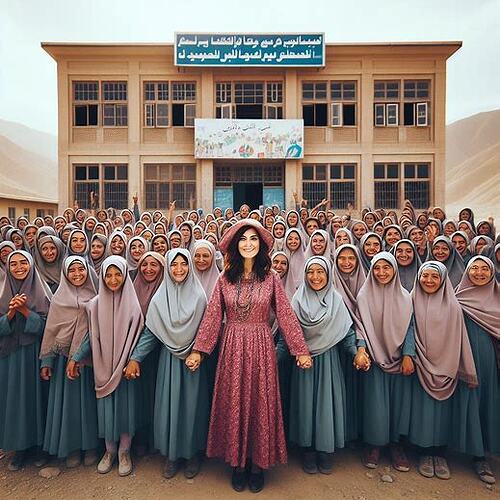Problems of Afghan women
Afghan women face a series of serious and complex challenges that are manifested in various social, economic, legal and cultural fields. Some of the most important problems of women in Afghanistan are:
- Limited rights and freedoms
- Education: Many Afghan girls are denied access to education due to cultural, economic and security factors. Even in areas where schools exist, security threats and family pressures prevent girls from continuing their education.
Forced and early marriages: Many girls are forced to marry at a young age and without their consent, which has negative effects on their physical and mental health.
- Violence and discrimination
- Domestic violence: Afghan women face widespread domestic violence and often do not have access to legal protection and services to protect themselves.
Discrimination in the workplace: Women face widespread discrimination in the workplace and have fewer job opportunities than men. Even when they do have access to work, they often receive lower wages and benefits.
- Domestic violence: Afghan women face widespread domestic violence and often do not have access to legal protection and services to protect themselves.
- Limited access to health services
- Health and medical care: Access to health and medical services for women is very limited, especially in rural areas. Pregnant women and children often do not have access to proper health services.
- Mental Health: Mental problems caused by war, violence and poverty are also widespread among Afghan women, but there are not enough services to support their mental health.
4 legal and legal obstacles
- Unequal laws: Existing laws are often drafted in favor of men and to the disadvantage of women. Women face legal restrictions in many cases, including divorce, inheritance and custody of children.
- Non-enforcement of laws: Even in cases where there are protective laws for women, their implementation is weak and women often cannot claim their rights.
- Traditional and cultural roles
- Traditional roles: Traditional and patriarchal culture assigns limited roles to women and limits them mainly to domestic and family roles.
Resistance to change: Efforts to change the status of women often face cultural and social resistance, which makes progress in women’s rights difficult.
- Traditional roles: Traditional and patriarchal culture assigns limited roles to women and limits them mainly to domestic and family roles.
6. War and insecurity
- Effects of war: War and continuous insecurity have had destructive effects on women’s lives. Many women have become homeless due to war and have lost access to basic life resources such as food, water and shelter.
Solving these problems requires extensive and coordinated efforts at different social, governmental and international levels. Supporting women’s rights, creating educational and economic opportunities, and reforming discriminatory laws can help improve the situation of women in Afghanistan.
Problems of women in the Taliban government
The Taliban government has aggravated the problems of Afghan women and imposed stricter restrictions on their rights and freedoms. Some of the most important problems of women under the Taliban regime are:
-
Educational limitations
- Closing girls’ schools: The Taliban have closed girls’ schools in many areas and severely limited girls’ access to education. In cases where study permits are granted, strict conditions apply.
Limitations in higher education: Due to Taliban restrictions, women cannot access universities and institutions of higher education, or in limited cases, they are allowed to study in certain fields.
- Closing girls’ schools: The Taliban have closed girls’ schools in many areas and severely limited girls’ access to education. In cases where study permits are granted, strict conditions apply.
-
Occupational limitations
- Prohibition of work: The Taliban do not allow women to work in many jobs. Even where work is allowed, strict restrictions apply and women can only work in certain occupations such as teachers and nurses.
- Gender segregation: In work and educational environments where women are allowed to attend, strict gender segregation is applied, which limits work and educational opportunities for women.
-
Travel restrictions
- Accompanied by a man: Women must be accompanied by a mahram man to leave the house. These strict restrictions negatively affect women’s freedom of movement and complicate their daily lives.
Travel prohibitions: Women need permission from the men of the family to travel outside the city or country, which also imposes serious restrictions on women’s freedom.
- Accompanied by a man: Women must be accompanied by a mahram man to leave the house. These strict restrictions negatively affect women’s freedom of movement and complicate their daily lives.
-
Mandatory coverage
Mandatory Hijab: The Taliban have made it mandatory for women to wear a full hijab (burqa). Failure to comply with these rules will result in severe penalties.- Dress restrictions: Women should wear clothes that cover their entire body and face and avoid colorful or attractive clothes.
-
Limited rights and freedoms
Lack of access to justice: The Taliban’s judicial system operates on the basis of strict interpretations of Islamic Sharia law, which severely restricts women’s rights. Women face serious discrimination in many cases, including divorce, custody of children, and inheritance.
Social Restrictions: The Taliban prohibit women from participating in many social activities, including participation in demonstrations, public gatherings, and participation in social decision-making. -
Violence and threats
- Domestic violence: Afghan women under the Taliban rule are facing an increase in domestic violence and often cannot get legal protection.
- Threats and terror: Women active in the fields of human rights, education and journalism face life threats and attacks, and many have been forced to leave their activities.
-
Health and hygiene
Limited access to health services: Taliban restrictions have limited women’s access to health services. Pregnant women and children face serious problems in accessing health care.
These restrictions and problems of women in the Taliban regime not only violate their human rights but also hinder the progress and social and economic development of Afghanistan. Addressing these problems requires international efforts and extensive support for the rights of Afghan women.

